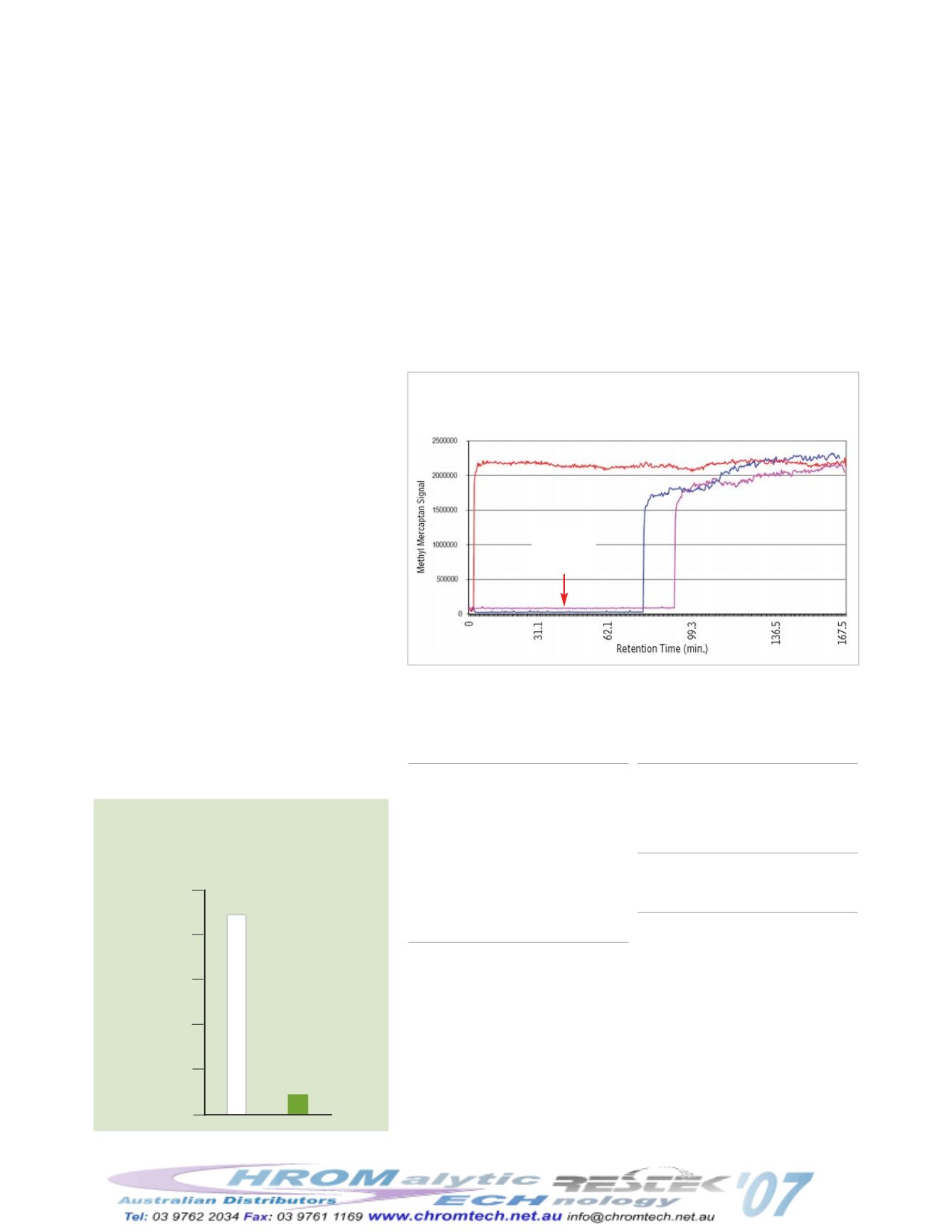

•
20
•
2007.01
Extend Process Component Lifetime and Enhance Durability
Restek Surface Treatments Improve Sampling and Transfer Component Performance
by Marty Higgins and Carrie Sprout, Restek Performance Coatings Division
• Economical—lower cost than specialty alloys, more durable than traditional stainless steels.
• Versatile—suitable in a variety of environments and temperature ranges.
• Simple—can be applied to existing equipment; stock tubing and fittings also available.
Adsorption problems in sample pathways often
can be traced to the tubing and fittings used to
transfer the sample to the analytical instrument.
Always use deactivated tubing and fittings for
applications involving active compounds. For spe-
cial requirements, ensure maximum inertness and
minimal surface area by applying the deactivating
treatment to electropolished tubing. Figure 1
shows uptake and release curves for 500ppbv of
methyl mercaptan, an active sulfur compound, in
a gas stream passing through a variety of tubing
substrates.
1
Siltek®/Sulfinert® treated tubing
reduces uptake by orders of magnitude, relative to
untreated stainless steel tubing.
In corrosive environments, Silcosteel®-CR treated
tubing is an excellent alternative to expensive
alloys. Silcosteel®-CR treatment extends the life-
time of the tubing, reducing the frequency of pre-
ventive maintenance and helping to ensure the
purity of the process or sample stream.
†
Silcosteel®-CR improves corrosion resistance by
up to 10X over untreated 316 stainless steel (per
ASTM G48 Method B, see graph below).
When surface activity or corrosion are a concern, solutions must be engineered. The Restek Performance Coatings group offers a
family of surface treatments that address activity and corrosion concerns over a wide spectrum of applications. Table 1 lists applica-
tions in which a Restek Performance Coating treatment of sample pathway components prevents adsorption of active compounds,
thereby contributing toward reliable and accurate information, or greatly reduces corrosion.
Figure 1
Sulfinert® treated electropolished seamless stainless
steel tubing (red) does not adsorb methyl mercaptan (500ppbv).
Blue-untreated electropolished tubing; violet-raw tubing.
Sulfur compounds in:*
automotive exhaust
beverage grade CO
2
diesel fuels
environmental samples
ethylene
gasoline
liquefied petroleum gas
natural gas (odorants)
propylene
stack gas emissions
wines and beers
Nitric oxide (NOx) compounds in:*
automotive exhaust
stack gas emissions
Mercury compounds in:*
crude oil
environmental samples
exhaust
stack gas emissions from coal fired electric
power plants
Corrosive environments:**
hydrochloric acid
hydrogen peroxide
seawater
Moisture hold-up in high purity sampling lines**
sample systems
gas delivery systems
process systems
Table I
Applications in which Restek treated sample pathway
components minimize corrosion** or prevent adsorption of active
compounds*.
methyl
mercaptan
adsorbed
*Siltek
®
/Sulfinert
®
treatment.
**Silcosteel
®
-CR treatment.
†
Note that with any corrosive stream, regular inspections are needed to confirm there are no leaks or break-
throughs.
Silcosteel®-CR treated stainless steel
outperforms uncoated metal
by an order of magnitude!
(ASTM G 48, Method B).
0
50
100
150
200
250
Untreated 316 SS
Silcosteel
®
-CR
weight loss in grams per square meter











